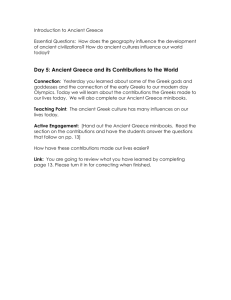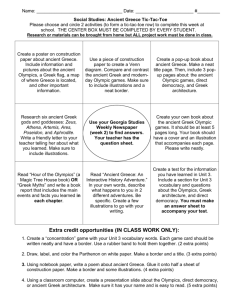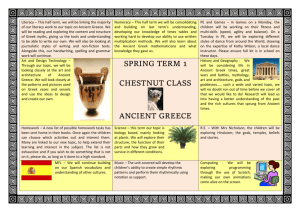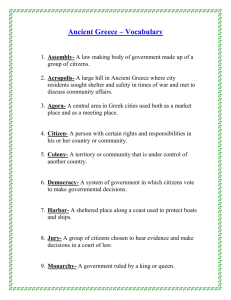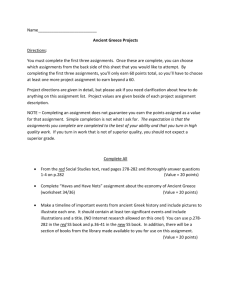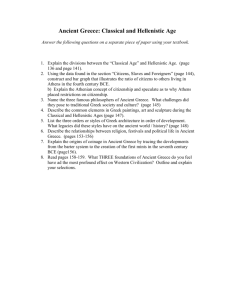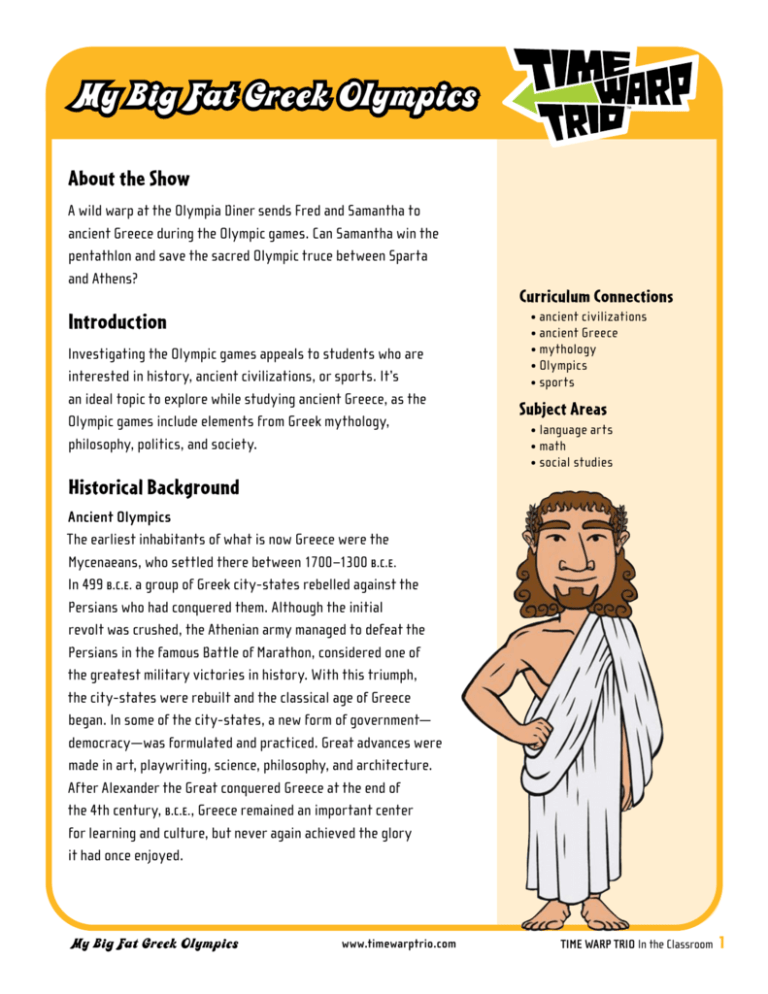
My Big Fat Greek Olympics
About the Show
A wild warp at the Olympia Diner sends Fred and Samantha to
ancient Greece during the Olympic games. Can Samantha win the
pentathlon and save the sacred Olympic truce between Sparta
and Athens?
Introduction
Investigating the Olympic games appeals to students who are
interested in history, ancient civilizations, or sports. It’s
an ideal topic to explore while studying ancient Greece, as the
Olympic games include elements from Greek mythology,
philosophy, politics, and society.
Curriculum Connections
• ancient civilizations
• ancient Greece
• mythology
• Olympics
• sports
Subject Areas
• language arts
• math
• social studies
Historical Background
Ancient Olympics
The earliest inhabitants of what is now Greece were the
Mycenaeans, who settled there between 1700–1300 B.C.E.
In 499 B.C.E. a group of Greek city-states rebelled against the
Persians who had conquered them. Although the initial
revolt was crushed, the Athenian army managed to defeat the
Persians in the famous Battle of Marathon, considered one of
the greatest military victories in history. With this triumph,
the city-states were rebuilt and the classical age of Greece
began. In some of the city-states, a new form of government—
democracy—was formulated and practiced. Great advances were
made in art, playwriting, science, philosophy, and architecture.
After Alexander the Great conquered Greece at the end of
the 4th century, B.C.E., Greece remained an important center
for learning and culture, but never again achieved the glory
it had once enjoyed.
My Big Fat Greek Olympics
www.timewarptrio.com
Time Warp Trio In the Classroom
My Big Fat Greek Olympics
Historical Background continued
The Olympics
The first recorded Olympics occurred in 776 B.C.E. Part of a festival honoring Zeus, it was one of four Pan
Hellenic (all-Greek) Games held in ancient Greece, each honoring a different god. The games were held at
Olympia, a religious sanctuary near the west coast of Greece. For more than a thousand years, the Olympic
games took place every four years in August without a single cancellation. The last recorded Olympics
were in 393 B.C.E. The following year the emperor Theodosius banned the worship of all but the Christian god.
The games, which were also a way to help men keep fit for war, were at first made up of only short
foot races. Men competed in the nude. Even when other events were added, there were no team sports.
No medals were awarded. The winner (there were no second or third place winners) was given a wreath
of olive leaves. These were cut from a sacred tree that stood behind the temple of Zeus at Olympia.
Women were not allowed to compete and married women were not even allowed to attend the games.
A separate women’s festival, the Heraia, was held in honor of Hera, wife of Zeus.
At the height of their popularity, 20,000–40,000 people attended the games. The event was so prestigious
that the city-states of ancient Greece observed a special truce, during which all hostilities were suspended
for a month before the games. Men could train and spectators could make their journeys in peace.
Merchants also came to the games to sell food and other wares.
In 1894, a French nobleman, the Baron Pierre de Coubertin, proposed that the games be revived. Two years
later the first modern Olympic games were held in Athens. Since 1924, both winter and summer games have
been played at designated sites all over the world.
re
Want students to get even mo
excited about hi story?
Check out the ancient Olympics adventure for kids at
www.timewarptrio.com/adventures/olympics/
Put It Back, Jack! and other interactive games to play.
P lentifax 487—the ultimate time traveler’s guide—gives facts about
ancient Greece, the Olympics, and more!
Cool Books that kids will love.
My Big Fat Greek Olympics
www.timewarptrio.com
Time Warp Trio In the Classroom
Activity 1
What’s in a Name?
This activity provides students with a chance to become
more familiar with Greek tales and myths, and to understand
their influence on modern culture.
Instructions
1. D iscuss with students the influence of Greek tales such as The Iliad
and The Odyssey, as well as Greek mythology, on our language.
Give examples of terms that come from Greek myths or stories and
how the imagery associated with these tales have contributed to our
culture. For instance, Nike, the messenger of the gods, was very fast,
since the gods had little patience. In addition to contributing his name
to an athletic shoe company, his symbol of winged sandals is used by
a florist, signaling that their flowers will arrive quickly.
2. Distribute the “Terms Derived from Greek Tales” handout. Individually,
in pairs, or in groups, assign students a Greek myth or story to research.
3. Distribute the “Pitch Your Product” handout. Have students draw a
picture to illustrate the term and then write the myth or story in their
own words in the appropriate space on the handout.
4. A sk students to think of an advertising pitch that might include the
term. Using the handout, students will first have to choose or imagine
a product, company, or person that could be promoted by the use of
the Greek name or associated symbol. It could be that the product helps
the user do something (“Don’t make cleaning a Herculean effort!
Use Clean-All instead.”), is named after the term (“Listen to the new
CD by singer Aurora Borealis. It’s heavenly!”), or embodies the qualities
of the term (“Midas Touch Investments turns your money to gold.”).
5. H ave students present their pitch. Make sure they explain why the
name, the myth, and its symbolism are ideal for expressing the product,
company, etc.
My Big Fat Greek Olympics
www.timewarptrio.com
Objectives
• t o develop narrative writing
skills
• to explore word origins
• t o enhance students’ familiarity
with Greek myths
• t o become more media literate
Materials
• art and writing supplies
• “ Terms Derived from Greek Tales”
handout
• “Pitch Your Product” handout
Curriculum Standards
• NCSS
Culture: Students will explain
and give examples of how
language, literature, and the
arts contribute to the
development and transmission
of culture.
• NCTE/IRA
Students read a wide range
of print and non-print texts to
build an understanding of texts,
of themselves, and of the
cultures of the United States
and the world; to acquire new
information, to respond to the
needs and demands of society
and the workplace; and for
personal fulfillment. Among
these texts are fiction
and nonfiction, classic and
contemporary works.
Time Warp Trio In the Classroom
TERMS DERIVED FROM GREEK TALES
ACHILLES HEEL
NARCISSUS
ACHILLES TENDON
NIGHT
AMAZON
NIKE
ATLAS
OCEAN
AURORA BOREALIS
ODYSSEY
CEREAL
OLYMPICS
ECHO
PANDORA’S BOX
EUROPE
PANIC
GIGANTIC
PHOENIX
HERCULEAN EFFORT
PSYCHOLOGY
HYACINTH
SIREN
HYGIENE
SIREN SONG
HYPNOSIS
SPHINX
IRIS
TANTALIZE
MARS
TITANIC
MARTIAL
URANIUM
MEDICINE
VOLCANO
MIDAS TOUCH
MUSEUM
MUSIC
My Big Fat Greek Olympics
www.timewarptrio.com
Time Warp Trio In the Classroom
© 2006 WGBH Educational Foundation.
Pitch Your Product
TERM
Draw a picture to illustrate the term.
Explain the myth or tale.
Think of a product and an advertising pitch.
Write about them below.
Explain why the name, the myth,
and its symbolism are ideal for expressing
your project, company, etc.
My Big Fat Greek Olympics
www.timewarptrio.com
Time Warp Trio In the Classroom
© 2006 WGBH Educational Foundation.
Activity 2
Pentathlon
In “My Big Fat Greek Olympics,” the judge decrees that Samantha
must throw the discus and wrestle—two of the five events that
made up the pentathlon. As Sam later explains, the pentathlon was
one of the most popular events in the Olympics, which also
included long jumping, running four different races, and javelin
throwing. In contrast, since 1912, the modern Olympic pentathlon
has consisted of shooting, fencing, swimming, riding, and crosscountry running.
In both the ancient and modern Olympics, the events were selected
to show an athlete’s versatility and breadth of ability. In this
activity, students take a survey and then hold a mock Olympics.
Instructions
1. D ivide the class into two groups. Have one group research the athletic
events in the ancient Olympics. Ask the other group to research the
events in the modern summer Olympics.
2. Have the two groups present their findings. As a class, create a Venn
diagram to compare and contrast the events. (The only common activity
is running.)
3. A sk for volunteers for an Olympic Committee. This group will be in charge
of collecting information from the class as to which of the 10 pentathlon
events (ancient and modern) they would most like to see and/or compete in.
The information can be collected by way of a survey, vote, petition, etc.
4. Have the Committee create a graph to indicate which five events students
have chosen.
Objectives
• t o compare and contrast the
modern and ancient Olympics
• to tally information
• to practice graphing
Materials
• writing supplies
• compass or string and a pin/nail
• protractor, ruler
Curriculum Standards
• NCSS
People, Places, & Environments: Students will estimate
distance, calculate scale,
and graph information.
• NCTE/IRA
Students adjust their use of
spoken, written and visual
language (e.g., conventions,
style, vocabulary) to
communicate effectively with
a variety of audiences and for
different purposes.
5. I n pairs or small groups, have students “compete” in the event on a mock
Olympic Game Day. Each group will be assigned one of the five events.
They can then decide how they would like to represent the event. They can
re-enact it, create a skit, describe it as if they were sportscasters, etc.
6. C ongratulate student groups with “wreaths” of victory using a variety
of criteria: most creative, most humorous, etc., so that each group
receives a wreath.
My Big Fat Greek Olympics
www.timewarptrio.com
Time Warp Trio In the Classroom
Resources
Recommended Books
For Teachers
Ancient Greek Athletics by Stephen
Miller. (Yale University Press, 2004)
An overview of the Pan Hellenic games,
events, and the role the games played
in society.
The Ancient Olympic Games, 2nd ed.
by Judith Swaddling. (University of Texas
Press, 2000)
Tracing the mythological and religious
origins of the games, this history
describes the events, ceremonies,
and celebrations of the games.
It includes a large, detailed model
of ancient Olympia.
The Ancient Olympics by Nigel Spivey.
(Oxford University Press, 2004)
A revealing look at the games as a
military, not just religious or social
event, as well as how Greek notions
of beauty and competitiveness have
influenced modern culture.
Games and Sanctuaries in Ancient
Greece by Panos Valvanis.
(Getty Trust Publications, 2004)
With more than 500 illustrations,
this is a study of the sporting tradition
in ancient Greece and the importance
of the Olympic games in Greek culture.
Games for the Gods: The Greek
Athlete and the Olympic Spirit
by John J. Hermann, Jr. and Christine
Kondoleon. (MFA Publications, 2004)
With over 140 illustrations of sculptures,
vases, coins, etc. this is an overview of
the ancient games and the Olympic spirit
through the ages.
The Greenwood Encyclopedia of Daily
Life, Volume 1 edited by Joyce E.
Salisbury. (Greenwood Press, 2004)
A comprehensive look at the lives of
ordinary people in ancient times—
their clothes, food, culture, customs,
beliefs, etc.
My Big Fat Greek Olympics
Sport and Society in Ancient Greece
by Mark Golden. (Cambridge University
Press, 1998)
Key Themes in Ancient History series.
A general introduction to the topic, this
book includes the origin and history
of the Olympic games.
For Students
Fiction
Asterix and the Olympic Games
by Rene Goscinny. (Orion, 2004)
Asterix, Obelix, and their friends enter
the ancient Olympics. Will they triumph
over the powerful Greek and Roman
athletes? For younger readers.
The Courtesan’s Daughter by Priscilla
Galloway. (Delacorte, 2002)
Fourteen-year-old Phanos, married
to Theo, tells the complicated story
of her stepmother, a former courtesan in
Athens. For older readers.
Goddess of Yesterday by Caroline B.
Cooney. (Delacorte, 2002)
Anaxandra, companion of the crippled
Princess Callisto, is the only survivor
after pirates attack their small island
home. Taken to Troy, she becomes
involved in the intrigue that leads to war
between Sparta and Troy.
Mr. Semolina-Semolinus: A Greek
Folktale retold by Anthony L. Manna.
(Atheneum, 1997)
In this folktale, Princess Areti is not
satisfied with any of her suitors so
she decides to make a man of her own.
Pandora of Athens, 399 B.C.
by Barry Denenberg. (Scholastic, 2004)
The Life and Times series. Pandora
is approaching the age at which she must
marry the man her father has chosen.
Will a chance meeting with the wise
teacher Socrates change her life?
www.timewarptrio.com
Say Cheese, Medusa!
by Kate McMullen. (Hyperion, 2002)
Myth-o-mania series. The story of
Perseus and the snake-haired Gorgon
Medusa is retold with a twist.
The Talisman by Lynne Ewing.
(Hyperion, 2003)
Daughters of the Moon series. As Maggie’s
life is nearing its end, she reflects on her
girlhood in ancient Athens.
Nonfiction
Ancient Greece by Matilde Bardi.
(Peter Bedrick Books, 2000)
Art and artifacts show how people
lived, traded, entertained, and fought
their enemies—and how the civilization
influenced how we live now.
Ancient Greece and the Olympics
by Mary Pope Osborne and Natalie Pope
Boyce. (Random House, 2004)
This companion book to the fictional
Hour of the Olympics describes the
research and facts that Osborne used
to write the novel.
Ancient Greek Olympics by Richard
Woff. (Oxford University Museum, 1999)
An examination of the games, covering
each of the five days of the athletic
and religious festival.
Ancient Greek Women by Haydn
Middleton. (Heinemann, 2003)
People in the Past series. The everyday
domestic tasks and responsibilities of
women in ancient Greece are described,
as well as the rare occasions when they
were able to appear in public. Other
titles include Ancient Greek Children,
Ancient Greek Homes, Ancient Greek Jobs.
Time Warp Trio In the Classroom
Resources
Ancient Medicine: From Sorcery
Swifter, Higher, Stronger:
A Photographic History of the
to Surgery by Michael Woods.
Summer Olympics by Sue Macy.
(Runestone, 1999)
A look at the medical practices and
(National Geographic, 2004)
innovations in ancient Egyptian, Indian,
Photographs portray the rebirth
Chinese, Greek, and Roman cultures and
of the ancient games, women in the
how they have influenced medicine today. Olympics, outstanding athletes,
controversies, and more.
Ancient Olympics by Jackie Graff.
(Heinemann, 2004)
A Visitor’s Guide to Ancient Greece
Information about the history, rules,
by Lesley Sims. (Usborne, 2003)
and organization of the Olympics.
If you could time travel, this book has
all you’d need for Athens: maps, tips on
The Gods and Goddesses of Olympus
where to stay, what to see, shopping,
by Aliki. (HarperCollins, 1994)
a section about side trips, and a
Introduces 15 major Greek gods and
traveler’s advisory to avoid Sparta!
goddesses with descriptions of their
special talents and responsibilities.
Poetry
Ancient Greece by Susan Altman
Olympia, Warrior Athletes of
and Susan Lechner. (Scholastic, 2001)
Ancient Greece by Dyan Blacklock.
Modern Rhymes About Ancient Times
(Walker, 2000)
series.
Contains 27 poems about
In the 8th century, B.C.E, the Greek cityfamous people, gods, goddesses,
states were embroiled in bloody and
buildings, myths, and other aspects
seemingly endless war with each other.
of
life in ancient Greece.
King Iphitus of Elis revives the ancient
athletic competition to distract the
warriors. For younger readers.
Web Sites
The Olympic Games: Athens 1896–
Athens 2004 by DK Publishing.
(DK Adult, 2004)
Hundreds of action photographs
chronicle the modern Olympics.
Ancient Greece
www.ancientgreece.com/
Explore various topics about ancient
Greece, such as the Olympics,
architecture, mythology, people,
and more.
The Original Olympics by Stewart Ross.
(Peter Bedrick Books, 1996)
The history, customs, and events of
the ancient Greek games.
Spend the Day in Ancient Greece
by Linda Honan. (John Wiley & Sons,
Inc., 1998)
Visit a fictional family in 432 B.C.E.,
join two children in their typical
activities, and make several projects
to understand life in ancient Athens.
Ancient Greece—Olympic
www.bbc.co.uk/schools/
ancientgreece/classics/olympics/
intro.shtml
This interactive comic book presents
facts about the ancient games as part
of a scavenger hunt game.
BBC History—The Ancient Greek
Olympic Gallery
www.bbc.co.uk/history/ancient/
greeks/greek_olympics_gallery.
shtml
Explore ancient artifacts and artwork
depicting the Olympic games.
Zeus
www.pantheon.org/articles/z/
zeus.html
Learn about Zeus, the supreme ruler
of Mount Olympus, and the other Greek
gods who lived there.
Mythography—The Greek God Zeus
in Myth and Art
www.loggia.com/myth/zeus.html
This site offers forums, information,
and artwork about Greek, Roman,
and Celtic myth and art.
Please note:
Although these sites were verified at the time
of publication, Web site addresses and content
are frequently subject to change.
The Ancient Olympics
www.perseus.tufts.edu/Olympics/
Created as a tribute to the 1996
Centennial Olympic games, this digital
library allows users to compare ancient
and modern Olympic games, learn about
famous athletes at the ancient games
and more.
©2006 WGBH Educational Foundation. All rights reserved. Time Warp Trio™ is produced by WGBH in association with Soup2Nuts for Discovery Kids. Major funding was provided by a grant from
the National Endowment for the Humanities. Any views, findings, conclusions, or recommendations expressed in these classroom materials do not necessarily represent those of the National
Endowment for the Humanities. Based on THE TIME WARP TRIO book series written by Jon Scieszka and illustrated by Lane Smith. Time Warp Trio is a registered trademark of Chucklebait, LLC.
Used with permission. Third party trademarks are the property of their respective owners. Used with permission.
My Big Fat Greek Olympics
www.timewarptrio.com
Time Warp Trio In the Classroom




